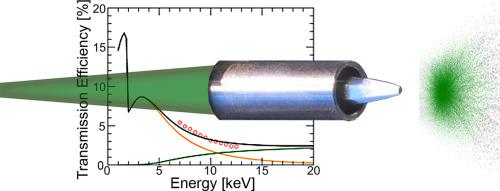当前位置:
X-MOL 学术
›
Spectrochim. Acta B. At. Spectrosc.
›
论文详情
Our official English website, www.x-mol.net, welcomes your
feedback! (Note: you will need to create a separate account there.)
An X-ray ray tracing simulation code for mono- and polycapillaries: Description, advances and application
Spectrochimica Acta Part B: Atomic Spectroscopy ( IF 3.2 ) Pub Date : 2020-11-01 , DOI: 10.1016/j.sab.2020.105974 Pieter Tack , Tom Schoonjans , Stephen Bauters , Laszlo Vincze
Spectrochimica Acta Part B: Atomic Spectroscopy ( IF 3.2 ) Pub Date : 2020-11-01 , DOI: 10.1016/j.sab.2020.105974 Pieter Tack , Tom Schoonjans , Stephen Bauters , Laszlo Vincze

|
Abstract Polycapillary optics, consisting of bundles of narrow hollow glass channels, are regularly used in the field of (micro-)X-ray fluorescence (XRF) spectroscopy to focus X-rays down to a microscopic spot while increasing the flux density of the beam on the sample. Polycapillaries guide X-ray photons through multiple total reflection events, similar to how light is guided within optic fibers. Although the use of polycapillaries in XRF spectroscopy allows for fairly straightforward qualitative elemental analysis, fundamental parameter (FP) based quantification remains difficult due to the energy dependent photon transmission efficiency, focal size, acceptance, etc. of these optics. In order to predict the polycapillary and input beam parameter dependent beam forming properties, a multithreaded Monte Carlo based polycapillary X-ray ray tracing code is presented. Apart from supporting photon ray tracing in ‘ideal’ straight, conical and ellipsoidal shaped polycapillary optics, it also allows for the simulation of photon propagation through arbitrarily shaped optics to account for small deviations from the ideal shape, as is often the case in real world examples. The current code allows for the simulation of so-called ‘leak events’, where the probability of a photon traveling through a capillary wall is taken into account, and also includes support for photon beam polarization effects. The simulated results show good agreement with experimental results obtained at the BM26A beamline of the European Synchrotron Radiation Facility (ESRF, Grenoble, France). The (poly)capillary X-ray ray tracing simulation code, called ‘polycap’, developed in the C language and with bindings for Python, is released under the GPLv3 license. The code is expected to assist in the quantification of (poly)capillary based X-ray fluorescence spectroscopy and may yield additional insight into the manufacturing and development of polycapillary optics.
中文翻译:

单毛细管和多毛细管的 X 射线射线追踪仿真代码:描述、进展和应用
摘要 多毛细管光学器件由一束狭窄的空心玻璃通道组成,经常用于(微)X 射线荧光 (XRF) 光谱领域,以将 X 射线聚焦到微观点,同时增加光束的通量密度。在样品上。多毛细管通过多个全反射事件引导 X 射线光子,类似于光在光纤内的引导方式。尽管在 XRF 光谱中使用多毛细管可以进行相当简单的定性元素分析,但由于这些光学器件的能量依赖光子传输效率、焦距大小、接受度等,基于基本参数 (FP) 的量化仍然很困难。为了预测多毛细管和输入光束参数相关的光束形成特性,提出了基于多线程蒙特卡罗的多毛细管 X 射线射线追踪代码。除了支持“理想”直线、圆锥形和椭圆形多毛细管光学器件中的光子射线追踪外,它还允许模拟光子通过任意形状的光学器件传播,以解决与理想形状的微小偏差,这在现实世界中经常发生例子。当前代码允许模拟所谓的“泄漏事件”,其中考虑了光子穿过毛细管壁的概率,并且还包括对光子束偏振效应的支持。模拟结果与在欧洲同步辐射装置(ESRF,格勒诺布尔,法国)的 BM26A 光束线上获得的实验结果非常吻合。(poly)毛细管X射线射线追踪模拟代码,称为“polycap”,用 C 语言开发并绑定 Python,在 GPLv3 许可下发布。该代码有望帮助量化基于(多)毛细管的 X 射线荧光光谱,并可能对多毛细管光学器件的制造和开发产生更多的了解。
更新日期:2020-11-01
中文翻译:

单毛细管和多毛细管的 X 射线射线追踪仿真代码:描述、进展和应用
摘要 多毛细管光学器件由一束狭窄的空心玻璃通道组成,经常用于(微)X 射线荧光 (XRF) 光谱领域,以将 X 射线聚焦到微观点,同时增加光束的通量密度。在样品上。多毛细管通过多个全反射事件引导 X 射线光子,类似于光在光纤内的引导方式。尽管在 XRF 光谱中使用多毛细管可以进行相当简单的定性元素分析,但由于这些光学器件的能量依赖光子传输效率、焦距大小、接受度等,基于基本参数 (FP) 的量化仍然很困难。为了预测多毛细管和输入光束参数相关的光束形成特性,提出了基于多线程蒙特卡罗的多毛细管 X 射线射线追踪代码。除了支持“理想”直线、圆锥形和椭圆形多毛细管光学器件中的光子射线追踪外,它还允许模拟光子通过任意形状的光学器件传播,以解决与理想形状的微小偏差,这在现实世界中经常发生例子。当前代码允许模拟所谓的“泄漏事件”,其中考虑了光子穿过毛细管壁的概率,并且还包括对光子束偏振效应的支持。模拟结果与在欧洲同步辐射装置(ESRF,格勒诺布尔,法国)的 BM26A 光束线上获得的实验结果非常吻合。(poly)毛细管X射线射线追踪模拟代码,称为“polycap”,用 C 语言开发并绑定 Python,在 GPLv3 许可下发布。该代码有望帮助量化基于(多)毛细管的 X 射线荧光光谱,并可能对多毛细管光学器件的制造和开发产生更多的了解。











































 京公网安备 11010802027423号
京公网安备 11010802027423号